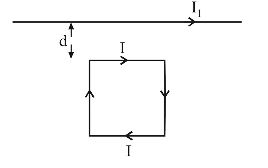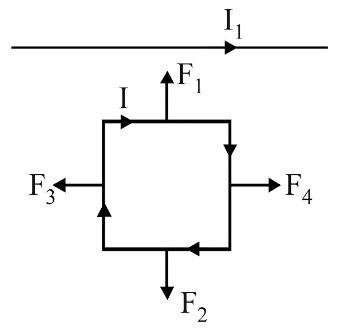Moving Charges and Magnetism
- A square loop, carrying a steady current I, is placed in a horizontal plane near a long straight conductor carrying a steady current I1 at a distance d from the conductor as shown in figure. The loop will experience

-
View Hint View Answer Discuss in Forum

F1 > F2 as and F3 and F4 are equal and opposite. Hence, the net attraction force will be towards the conductor.Correct Option: D

F1 > F2 as and F3 and F4 are equal and opposite. Hence, the net attraction force will be towards the conductor.
- A galvanometer of resistance, G is shunted by a resistance S ohm. To keep the main current in the circuit unchanged, the resistance to be put in series with the galvanometer is
-
View Hint View Answer Discuss in Forum
To keep the main current in the circuit unchanged, the resistance of the galvanometer should be equal to the net resistance.
∴ G = 
GS 
+ S' G + S ⇒ G - GS = S' G + S ∴ S' = G² = S' G + S 
Correct Option: C
To keep the main current in the circuit unchanged, the resistance of the galvanometer should be equal to the net resistance.
∴ G = 
GS 
+ S' G + S ⇒ G - GS = S' G + S ∴ S' = G² = S' G + S 
- A galvanometer has a coil of resistance 100 ohm and gives a full-scale deflection for 30 mA current. It is to work as a voltmeter of 30 volt range, the resistance required to be added will be
-
View Hint View Answer Discuss in Forum
Let the resistance to be added be R, then 30 = Ig (r + R)
∴ R = 30 - r = 30 - 100 Ig 30 × 103
= 1000 – 100 = 900 ΩCorrect Option: A
Let the resistance to be added be R, then 30 = Ig (r + R)
∴ R = 30 - r = 30 - 100 Ig 30 × 103
= 1000 – 100 = 900 Ω
- A galvanometer having a coil resistance of 60 Ω shows full scale deflection when a current of 1.0 amp passes through it. It can be converted into an ammeter to read currents upto 5.0 amp by
-
View Hint View Answer Discuss in Forum
G = 60ω Ig = 1.0A, I=5A.

Let S be the shunt resistance connected in parallel to galvanometer
Ig G = (I – Ig) S, S = IgG = 1 × 60 = 15 Ω I - Ig 5 - 1
Thus by putting 15Ω in parallel, the galvanometer can be converted into an ammeter.Correct Option: C
G = 60ω Ig = 1.0A, I=5A.

Let S be the shunt resistance connected in parallel to galvanometer
Ig G = (I – Ig) S, S = IgG = 1 × 60 = 15 Ω I - Ig 5 - 1
Thus by putting 15Ω in parallel, the galvanometer can be converted into an ammeter.
- A galvanometer of resistance 50 Ω is connected to battery of 3V along with a resistance of 2950 Ω in series. A full scale deflection of 30 divisions is obtained in the galvanometer. In order to reduce this deflection to 20 divisions, the resistance in series should be
-
View Hint View Answer Discuss in Forum
Total internal resistance = (50+2950) Ω
= 3000 Ω
Emf of the cell, ε = 3V∴ Current = ε = 3 = 1 × 10-3A = 1.0 mA R 3000
∴ Current for full scale deflection of 30 divisions is 1.0 mA.
∴ Current for a deflection of 20 divisions, I = 
20 × 1 
mA or I = 2 mA 30 3
Let the resistance be x Ω. Thenx = ε = 3V = 3 × 3 × 103 Ω I 
2 × 103A 
2 3
= 4500 Ω
But the resistance of the galvanometer is 50Ω.
∴ Resistance to be added = (4500 –50) Ω = 4450 ΩCorrect Option: D
Total internal resistance = (50+2950) Ω
= 3000 Ω
Emf of the cell, ε = 3V∴ Current = ε = 3 = 1 × 10-3A = 1.0 mA R 3000
∴ Current for full scale deflection of 30 divisions is 1.0 mA.
∴ Current for a deflection of 20 divisions, I = 
20 × 1 
mA or I = 2 mA 30 3
Let the resistance be x Ω. Thenx = ε = 3V = 3 × 3 × 103 Ω I 
2 × 103A 
2 3
= 4500 Ω
But the resistance of the galvanometer is 50Ω.
∴ Resistance to be added = (4500 –50) Ω = 4450 Ω

